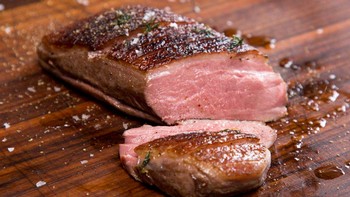Larry Stone's Duck Recipe
This recipe is quite simple and perfect for a wide range of Pinot Noirs and terrific with complex or mature wines as the seasoning subtly enhances the flavors of the dish rather than fighting them. My version below was adapted from Liberty Duck Farm’s recipe.
Purchase a high-quality, plump duck breast - one per person. I buy them online from D'Artagnan and when I lived in Northern California, I purchased them fresh from Liberty Ducks in Sonoma. If there is a good local farm with fresh duck, buy from them.
My recipe is very easy - duck is so flavorful that not much needs to be done.
Ingredients:

-
High-quality, plump duck breast - one per person (see notes above)
-
Canola or Grapeseed Oil
-
Cardamom
-
Salt & Pepper
Preparation:
I rinse and dry the duck, trim the fat cap at the edges to fit nicely on the meat surface and not hang over. I salt lightly all over, make parallel diagonal slits across the surface of the fat, about 5mm apart. This cuts the surface of the skin and allows the fat to render without curling.
Then coat the duck all over with ample ground cardamom. Air dry it with a fan for around 20 minutes so that the meat and fat are very dry on the surface. Air drying prevents some sticking to the pan and prevents some loss of meat juices.
Take a hot aluminum, cast iron or high-quality stainless-steel skillet or sauté pan (not non-stick) of sufficient size that allows for ample room for each breast. Pre-heat on stove. When hot, drop a little grapeseed or canola oil on the surface of the pan and spread it around by rotating the pan in a circular motion. It should be just enough so that the duck will not stick to the pan before rendering its fat.
Lay the breasts skin side down in the pan. Move breasts around frequently when first getting them in the pan to avoid their sticking. After a few minutes and when the fat starts to render and the skin begins to brown, turn the heat to a medium to medium-high temperature depending upon how hot your range burns. Too hot and the skin will burn, lower is better to have time to let the fat render and leave a thin tasty layer of fat on the breast with a crispy brown to dark black surface.
The idea is to render the fat without overcooking the meat. One could have a can on the side to dump excess duck fat as it melts, but that would be a waste. As the fat renders and starts to build up in the pan, pour the excess fat into a glass container that can be sealed. It may be necessary to go through this a couple of times before the duck is done. This duck fat is delicious to fry potatoes with, collard or mustard greens, broccoli rabe or anything that you may want to cook with bacon fat. It can be frozen and stored for months or kept in the refrigerator for several weeks. This fat will also have a subtle flavor of cardamom.
When the skin becomes dark mahogany-colored and the meat appear to have cooked almost halfway up the side of the breast, then turn over the breasts and finish frying them in a few minutes. If you like your duck breast rare, let it only seem to begin to cook up the sides (you can tell by the change in color of meat from dark red to a brownish white) and then sear meat side down for only a couple of minutes.
Eat the lean slices of duck breast together with the layer of crisp fragrant fat, which tastes and smells a lot like an elevated type of bacon. The combination of the meat and cardamom used as a savory spice is quite compelling with Lingua Franca Estate Pinot Noir, The Plow, or Mimi's Mind. Enjoy!